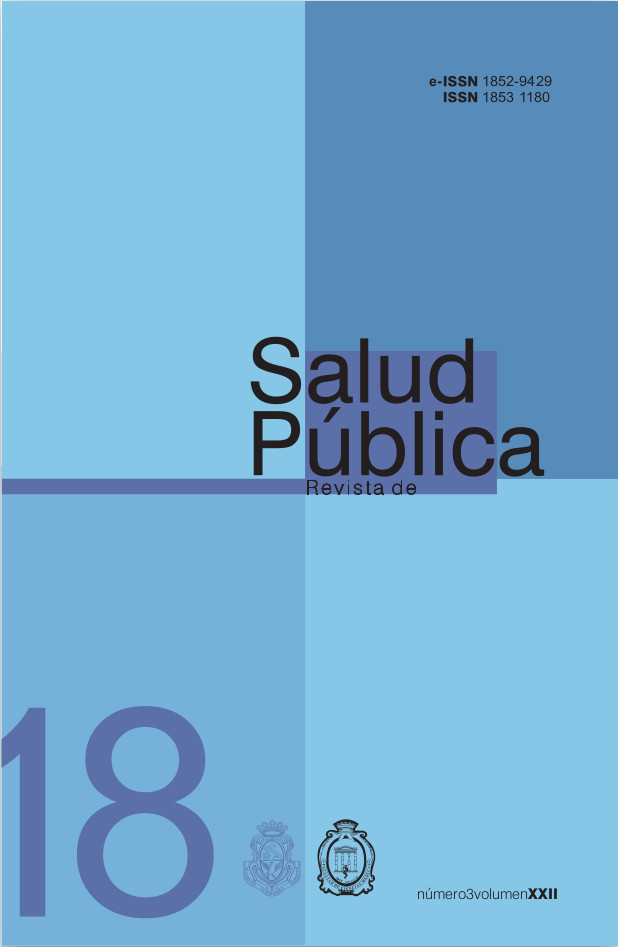QI GONG: MIND BODY TECHNIQUE FOR HEALTH PROMOTION. Experience at Hospital San Martin, La Plata. Argentina. Period 2014- 2017
DOI:
https://doi.org/10.31052/1853.1180.v22.n3.20254Keywords:
Psychosocial stress, chronic pain, life quality, Qi GongAbstract
Objective: To analyze the perceptions regarding the use of a mind-body technique for health promotion (Qi Gong) at a public hospital in the city of La Plata, Argentina. Material and Methods: Qualitative research was done, based on discourse analysis. In depth interviews were carried out. The program Atlas Ti was used for the analysis. Results: Participants refer benefits of the technique in the physical, emotional and social dimensions. Conclusions: According to the participants› reports, the use of the technique results beneficial. It is necessary to continue exploring the benefits of the technique, using other research designs, to assess its clinical effectiveness.
Downloads
References
1. Chu, D.A. Tai chi, Qi Gong and Reiki. Phys.Med Rehabil Clin N. Am. (2004) 15, 773-781.
2. Fredrickson BL1, Boulton AJ1, Firestine AM Positive Emotion Correlates of Meditation Practice: A Comparison of Mindfulness Meditation and Loving-kindness Meditation. Mindfulness (N Y). 2017 Dec;8(6):1623-1633. doi: 10.1007/s12671-017-0735-9. Epub 2017 May 29.
3. Galvanese ATC1, Barros NF2, D'Oliveira AFPL1.Contributions and challenges associated with bodily practices and meditation for health promotion in the public primary care system in the city of São Paulo, Brazil. Cad Saude Publica. 2017 Dec 18;33(12).
4. Guo Lin. Why can cure cancer. Power management articles by GUO LIN. ZHU GUO LIN XIN QI GONG YAN JIU HUI YAN JIU HUI. ZHENG LI (1991).
5. Irwin RR, Pike JL, Cole JC (2003) Effects of a behavioral intervention, Tai chi, on varicella zoster virus specific immunity and health functioning in older adults. Psychosom Med 65, 824-830.
6. Jadad AR, Cabrera A, Martos F, Smith R, Lyons RF. Cuando las personas viven con múltiples enfermedades crónicas: aproximación colaborativa hacia un reto global emergente. Granada: Escuela Andaluza de Salud Pública; 2010. Disponible en:http://www.opimec.org/equipos/when-people-live-with-multiple-chronic-diseases/ .
7. Kim SH1, Schneider SM, Kravitz L, Mermier C, Burge MR. Mind-body practices for posttraumatic stress disorder. J Investig Med. 2013 Jun;61(5):827-34.
8. Lee MS, Pittler MH, Ernst E. Internal Qi Gong for pain conditions: A systematic review. ( 2009) J. Pain 10, 1121-1127,e1114.
9. Lee, MS Pittler MH, Ernst E. (2007). External Qi Gong for pain conditions. A systematic review of randomized clinical trials. J. Pain 8, 827-831.
10. Loucks, E. B., Schuman-Olivier, Z., Britton, W. B., Fresco, D. M., Debordes, G., Brewer, J. A., Fulwiler, C. (2015) “Mindfulness and Cardiovascular Disease Risk: State of the Evidence, Plausible Mechanisms, and Theoretical Framework” Current Cardiology Reports 17:112.
11. Pang Ming. The methods of Zhineng Qi Gong Practice. ISBN 978-0-473-24231-2. April 2013.
12. Park SH, Han KS. Blood Pressure Response to Meditation and Yoga: A Systematic Review and Meta-Analysis. J Altern Complement Med. 2017 Sep;23(9):685-695. doi: 10.1089/acm.2016.0234. Epub 2017 Apr 6.
13. Rendant D, Pach D, Ludthe R Meisshauer A ( 2011). Qi Gong versus no therapy for patients with chronic neck pain: A randomized controlled trial. Spine 36, 419-427.
14. S.Blodt, Pach D, Kaster T. Qi Gong versus exercise therapy for chronic low back pain in adults. A randomized controlled non-inferiority trial. Eur J Pain (2015) 123-131.
15. http://apps.who.int/medicinedocs/documents/s21201es/s21201es.pdf
Downloads
Published
Issue
Section
License
Copyright (c) 2018 Escuela de Salud Pública y Ambiente. Facultad de Ciencias Médicas. Universidad Nacional de Córdoba

This work is licensed under a Creative Commons Attribution-NonCommercial 4.0 International License.
Authors who publish with this journal agree to the following terms:
- Authors retain copyright and grant the journal right of first publication with the work simultaneously licensed under a Creative Commons Attribution License which allows the work to be copied, distributed, exhibited and interpreted as long as it is not done for commercial purposes.
- Authors are able to enter into separate, additional contractual arrangements for the non-exclusive distribution of the journal's published version of the work (e.g., post it to an institutional repository or publish it in a book), with an acknowledgement of its initial publication in this journal.
- Authors are permitted and encouraged to post their work online (e.g., in institutional repositories or on their website) after the publication process. (See The Effect of Open Access). (See The Effect of Open Access).







